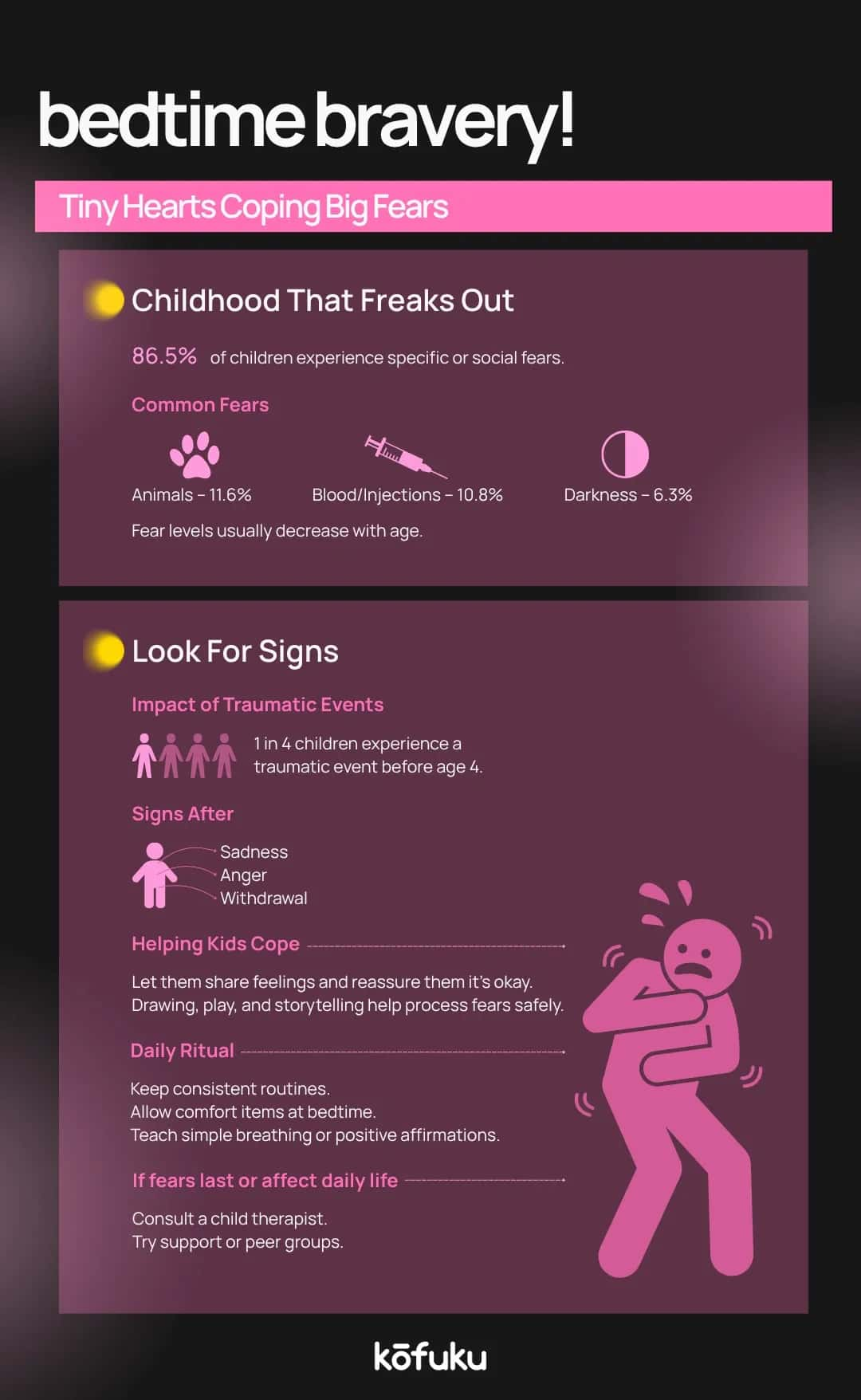Helping Children Cope with Scary Events and Fears

Introduction
Parents, often instinctively, don’t speak about some issues with their children to protect them from every pain and anxiety possible. This may be a natural disaster, an accident, or watching something sad and distressing on television.
However, this can lead to the opposite effect. On the other hand, addressing the issue constructively can be even more effective than silence and reassurance.
Understanding How Scary Events Affect Children’s Well-being
Whether it is a personal and direct encounter or the passive exposure of scary events through the media, a child’s sense of security is disrupted in many lasting ways.
Natural calamities, civil unrest, loss, or hospitalisation can trigger traumatic memories of fear and sadness that leave a child emotionally confused and sad.
The effects, however, depend on the child’s age. For instance, in younger kids, it may cause regressed behaviour, increased clinginess, or even nightmares. In older kids, it may lead to worries about safety and withdrawal.
As such, emotional presence is more valuable than clarity in these moments. Being present and encouraging them helps them feel safe, loved, and supported, which helps re-establish and restore trust and predictability.
Common Fears and Worries Children Experience in Difficult Times
Some common children’s worries and fears tend to reflect their developmental age. For example, toddlers have fears about separation and loud noises, and school-going children may worry about the death of loved ones, illnesses, and other dangers.
In contrast, teenagers often fear social rejection and other anxieties about the future. Recognising these patterns helps parents manage worries more sensitively.

Signs Your Child May Be Struggling with Emotional Stress
Some parents may miss some signs of distress. For example, worrying shifts in behaviour and distress. These may include sleep problems, withdrawal, clinginess, and irritability. For younger kids, these include_ bedwetting_ and thumb-sucking. Older kids may experience anxiousness, weakness, and apathy.
These signs usually mean that a child’s internal world feels unsafe. Consistent routines, a calm and patient adult, and circumstances that are not too demanding of a child’s control may help them during this time.
Why Talking About Fears Helps Children Feel Safer
Discussing one’s fears is one of the most effective ways to support children's emotional development. Do not dismiss worries with “don’t be scared” or “nothing like that will happen”.
These phrases are not validation. Respond with acknowledgement of the distress and something along the lines of, “I understand that this is frightening for you.”
Steps to Provide Emotional Support During Scary Events
To offer a child emotional support during scary situations, you must be calm. First, aim to provide physical and emotional safety. Minimise exposure to the troubling news and offer soothing, predictable routines. Be ready to respond to questions, doing so gently and honestly while staying close.
Creating a Safe Environment for Your Child
Ensuring a child's safety goes beyond simply keeping doors locked or rooms secure. It means creating a space where they feel emotionally anchored. Predictable routines, warm communication, and positive family interactions all contribute to this safety and security.
By limiting exposure to arguments, loud noise, and violent media, you will maintain a peaceful home atmosphere.

Tips for Managing Children’s Worries Day-to-Day
To create an atmosphere of calm and security, parents can incorporate a few small, consistent actions into everyday life. Some practical strategies to manage children’s worries include maintaining predictable routines, encouraging movement, and ensuring sufficient sleep. Promoting positive thinking and relaxation helps children manage their fears.
How Emotional Support Strengthens Coping Skills
Every child needs consistent emotional support. Emotional support helps to build mechanisms that will be useful throughout one’s life. They discover that emotions can be managed and that this helps develop problem-solving skills.
Role of Schools and Communities in Helping Children Feel Secure
Schools act as vital safe havens, where kind teachers provide a protected environment that supports both learning and children's overall well-being.
At the same time, the community actively contributes by offering safe spaces and a supportive network.
When these two groups work hand in hand, they ensure that every child feels a powerful sense of belonging and is consistently supported.
Activities to Help Children Relax and Build Resilience
Structured and creative activities can help children regain a sense of joy and normalcy. Art therapy, music, yoga, and journaling allow self-expression without pressure. Outdoor play, group sports, or mindfulness exercises also help release stress.
Stories and Play as Tools for Emotional Healing
Storytelling and pretend play allow children to externalise their fears and gain control over imagined scary situations. Developing hobbies for children and engaging them in such activities regularly helps build confidence and emotional resilience. They also help reduce anxiety in children.
Knowing When to Seek Professional Help
When distress lingers for weeks or longer, parents should seek help from a psychologist or child counsellor. Their professional advice and guidance help parents emotionally and teach children structured coping.
Early intervention helps avoid the internalising of trauma and helps prevent the development of long-lasting anxiety.
Helpful Resources for Parents and Caregivers
For parents seeking reliable support to help children cope, organisations such as UNICEF, Save the Children, and the National Institute of Mental Health (India) offer age-appropriate recommendations and referrals for counselling and coping strategies.

FAQs
Q. How can parents start helping children cope after a scary event?
A. Begin by reassuring your child that they are safe, listening patiently to their feelings, and maintaining familiar routines. Offer comfort, answer questions honestly, and limit exposure to distressing news or discussions.
Q. What are simple ways to talk to children about their fears?
A. Use calm, age-appropriate language. Encourage them to share what worries them, validate their emotions, and provide gentle reassurance. Avoid dismissing fears—listen, comfort, and help them find positive coping thoughts.
Q. How can I tell if my child needs emotional support?
A. Watch for changes in behaviour, sleep issues, withdrawal, clinginess, irritability, or regression. Persistent distress, anxiety, or silence after an event often indicates a need for additional emotional support.
Q. What daily habits help in managing children’s worries?
A. Maintain consistent routines, ensure enough rest, encourage physical play, limit media exposure, and share calm family time. Simple rituals like bedtime stories and open conversations reduce anxiety effectively.
Q. How can I make my home a safe environment for my child?
A. Create a peaceful space with stable routines, warmth, and open communication. Avoid loud arguments, maintain predictability, and offer comfort items or quiet zones where your child feels secure.
Q. What are the best activities for helping children relax after stressful events?
A. Encourage drawing, storytelling, music, outdoor play, or gentle breathing exercises. Calm, creative, and physical activities help children release tension, regain focus, and express emotions safely and naturally.

Navigating Parenthood: Adoptive Parenting Tips

A Guide for First-Time Parents in 2025 – Best Advice

Kid's Health Tips For Seasonal Illness: A Parent's Guide

Navigating the Mental Health of New Parents

Parenting Burnout: Know the Signs and How to Navigate Them


